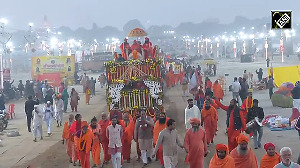It's like falling of a house of cards or role reversal. The big and hitherto established powerful nations could be at the lower end of the ladder if the predictions about BRIC (Brazil, Russia, India and China) comes true.
Now the stage is set for next month's first BRIC meet billed as the meeting of 'future big minds'.
Goldman Sachs Investment Bank in a paper in 2003 argued with facts, figures and importantly optimism that the economic potential of these four countries is such that they may become among the four most dominant economies by the year 2050. The thesis was proposed by the company's global economist Jim O'Neil.
It has unleashed euphoria of hopes among the people and the government(s) in these countries, but scepticism too persists as things can go haywire in the event of some topsy-turvy happening -- either man-made war or natural calamities.
The foreign ministers of Brazil, Russia, India and China will meet in Moscow in Spring 2008 to discuss issues of mutual interest in the international arena as also those relating to trade, development and financial system.
In the first phase, the ambassadors have already met and prepared ground to move things towards the political level.
The Indian side has already pinned its hopes, as an official said, "It will be good and a heart warming session if the BRIC nations turn out to be strong and affluent the way forecasts have been made".
The External Affairs Minister Pranab Mukherjee has already had several rounds of meetings with his counterparts and other top brasses of these countries. Similarly, Russian Foreign Minister Sergei Lavrov attended a ministerial meeting of the BRIC group in September, 2007
The next month's meet is now aimed at carrying forward the crucial 'four-way contacts' at various levels, including representatives of the four countries at international organisations.
Efforts are being made to expand the agenda of the debates and seeking ways to coordinate and interact on specific issues, especially economic cooperation.
The BRIC countries account for about 40% of the world population and each country has its own unique advantages.
Experts in Delhi say major countries in the group like India and China must examine various pros and cons and the limitations also along with inherent advantages posed by the economy of a small nation like Brazil.
Brazil has abundant natural resources, large agricultural industry and low interest rates to drive investments. Besides, there is increasing consumer appetite but the growth rate is pretty less compared to India's growth. Brazil's growth rate is still in the range of 4 %.
From Indian point of view, there are advantages like availability of a combination of educated and cheap labour force, adequate opportunities in infrastructure investment high growth rate of nearly 9% and the inherent resilience power to tackle all problems and pressures of globalisation.
Strategic experts say though primarily a forum seeking to excel in economic cooperation for mutual growth, the emphasis so far is on cooperation for dealing with various international issues. One way these do not touch Brazil.
Although Brazil will be at the talks attended by its foreign minister, the three original countries Russia, China and India will continue to push the agenda at 'RIC' front. An indication has been given by a senior Russian official in Delhi.
"BRIC will be based on economic and financial ties. While RIC will not exclude economic issues from its discussions, it will chiefly concentrate on international problems," said. Konstantin V. Vnukov, director of the first asian department in Russia's foreign ministry.
But the utterances should not be taken with any pessimistic touch, especially by India. In Indian context, as per the forecast made by Goldman Sachs, by 2032 India will be the 3rd largest economy with a high per capita income.
One factor, everyone agrees, which is going to make India's growth faster than other BRIC countries will be the number of working people.
As per the Goldman Sachs study India will have the highest working age population (15 to 60 years and the purchasing power parity is going to increase manifold.)
However, the areas like clearing of infrastructure bottlenecks ought to be seen and the vexing problem of poverty also eradicated to help the country attain the respectable position in the comity of nations.
It is to be noted that if the predictions come true and these countries channelise their economic cooperation activities in the right track, BRIC will grow to outstrip the currently dominant members of the global economy, G-6, (US, Britain, France, Japan, Germany and Italy) within next 50 years.
A more interesting point is that many of the current members of the G-7 may not be eligible to attend the meetings of the world's forthcoming largest economic powers.






 © 2025 Rediff.com -
© 2025 Rediff.com -